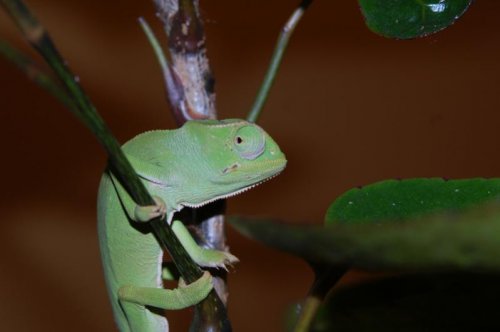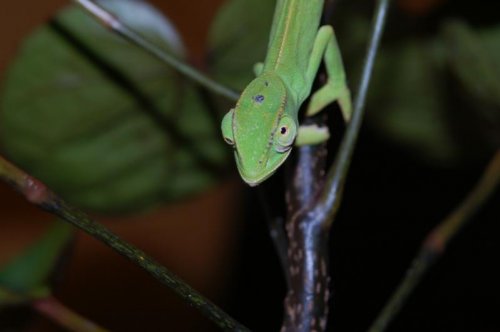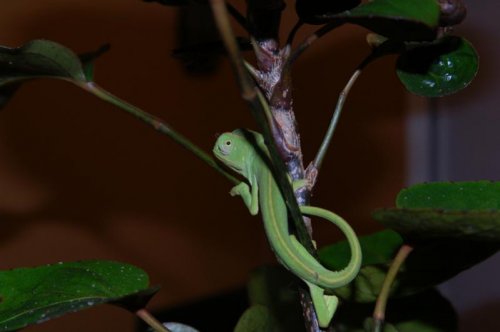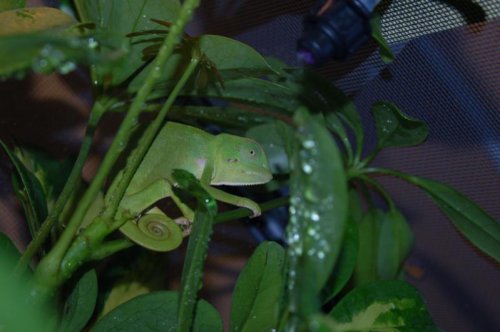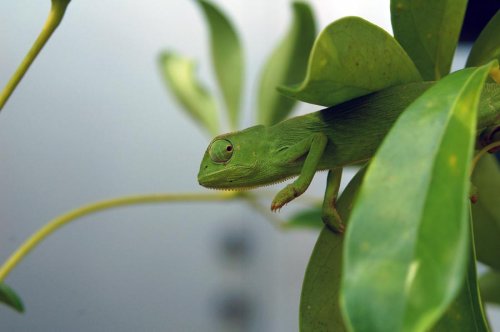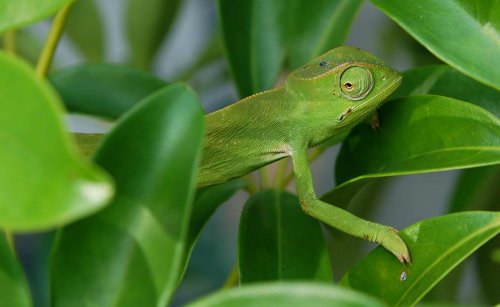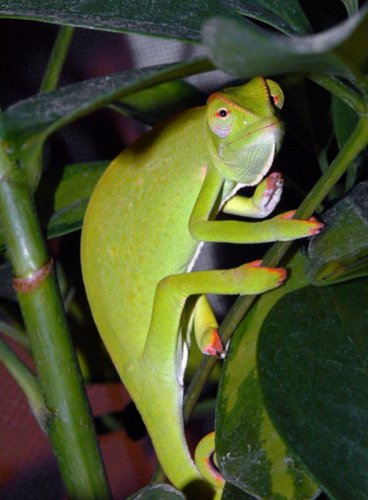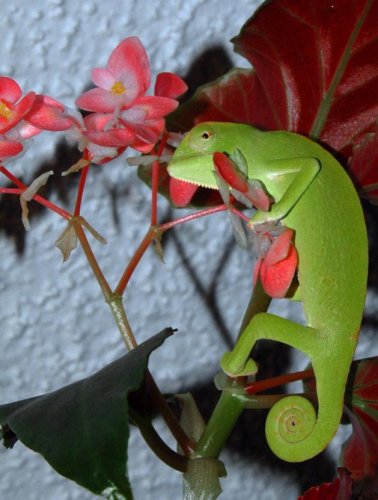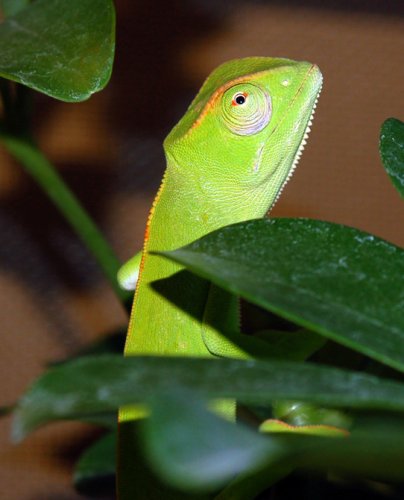luevelvet
Avid Member
Chamaeleo Senegalensis Experiences?
Hey Everyone,
I will apologize in advance for the long post...
I came across a very healthy juvenile Senegalensis at a local shop and have fallen absolutely in love with her. She’s approximately 3" SVL, maybe 4-5 with the tail. She's very clean looking with exception to a couple of small blemishes that looks very much like they will be gone during the next few sheds. I've seen her at the shop for the last two weeks, the last time being yesterday. She looked very comfortable, a bright green, and was actually hanging out in the open this week. She hasn't lost any weight in the two weeks they've had her and they claim that she eats like a champ.
Well, as I mentioned before, this little girl stole my heart and I've already made plans to purchase her. But, like any responsible chameleon keeper, I thought I would ask around before actually buying her to make sure I know what I'm in for. Based on the blemishes and the past history of this species, I'm almost 100% she’s WC, though by looking at her, you wouldn't necessarily think so. She’s very clean.
As a frame of reference for where I'm coming from, I've read almost all there is to be read online; including Kristina's article on Chameleon News (I don't know how this community can thank her enough). My intention is to start with one, get to know the species and it's quirks with a long term goal of acquiring a partner and researching its reproductive behaviors and breeding details. I'm not convinced that this hasn't been done already, but based on the lack of information online, it's not diversely documented. I intend to document all of my research and findings publicly so every can enjoy these humble and adorable creatures and maybe one day lessen the numbers that come from the wild.
With all of that being said, here is what I know so far:
Melle the Meller's has just moved into his free range setup (pics later) and I now have his old place up for rent. It's 18x18x36 and heavily planted.
Reptisun 5.0 of course, with a 60 watt basking lamp.
Automatic mister set to mist three times per day lasting ten minutes each session.
I hear they can handle temperature ranges from 76 - 96.
That's about all I have found of actual husbandry guidelines for them. I'm thinking that perhaps there isn't much difference between them and many of the rules of thumb for keeping chameleons, with exception to the importance of a heavy foliage and cover.
Now for the questions...I figured I would ask the advice of others who have cared for them long term.
Temperature and Humidity
What is the optimal temperature range for these guys? 76-96 is a wide range and I will keep good documentation to see which she prefers the most. Also, I can't imagine the mister not providing enough humidity throughout the day, but I can't find any specific info on their preferences so I thought I would ask, do they require specific humidity levels?
Breeding
I can't seem to find much, other than Kristina's article that mentions to much about breeding. Anyone have any info on this topic in regards to Senegalensis?
Please feel free to provide your thoughts, advice, criticisms etc as you wish in this thread. Any discussions regarding this species can be helpful moving forward.
On a side note, this potential project has reignited the idea to develop research tracking software to maintain easy to input and easy to review records of what's happening during the project. Hopefully I wll have something up in the next few months, we're still in the design phase.
If you've made it this far, thank you! I hope everyone who knows anything about this species will chime in a let it be known. For now, wish me luck and I will most certainly keep everyone updated.
Thanks,
Luis
Hey Everyone,
I will apologize in advance for the long post...
I came across a very healthy juvenile Senegalensis at a local shop and have fallen absolutely in love with her. She’s approximately 3" SVL, maybe 4-5 with the tail. She's very clean looking with exception to a couple of small blemishes that looks very much like they will be gone during the next few sheds. I've seen her at the shop for the last two weeks, the last time being yesterday. She looked very comfortable, a bright green, and was actually hanging out in the open this week. She hasn't lost any weight in the two weeks they've had her and they claim that she eats like a champ.
Well, as I mentioned before, this little girl stole my heart and I've already made plans to purchase her. But, like any responsible chameleon keeper, I thought I would ask around before actually buying her to make sure I know what I'm in for. Based on the blemishes and the past history of this species, I'm almost 100% she’s WC, though by looking at her, you wouldn't necessarily think so. She’s very clean.
As a frame of reference for where I'm coming from, I've read almost all there is to be read online; including Kristina's article on Chameleon News (I don't know how this community can thank her enough). My intention is to start with one, get to know the species and it's quirks with a long term goal of acquiring a partner and researching its reproductive behaviors and breeding details. I'm not convinced that this hasn't been done already, but based on the lack of information online, it's not diversely documented. I intend to document all of my research and findings publicly so every can enjoy these humble and adorable creatures and maybe one day lessen the numbers that come from the wild.
With all of that being said, here is what I know so far:
Melle the Meller's has just moved into his free range setup (pics later) and I now have his old place up for rent. It's 18x18x36 and heavily planted.
Reptisun 5.0 of course, with a 60 watt basking lamp.
Automatic mister set to mist three times per day lasting ten minutes each session.
I hear they can handle temperature ranges from 76 - 96.
That's about all I have found of actual husbandry guidelines for them. I'm thinking that perhaps there isn't much difference between them and many of the rules of thumb for keeping chameleons, with exception to the importance of a heavy foliage and cover.
Now for the questions...I figured I would ask the advice of others who have cared for them long term.
Temperature and Humidity
What is the optimal temperature range for these guys? 76-96 is a wide range and I will keep good documentation to see which she prefers the most. Also, I can't imagine the mister not providing enough humidity throughout the day, but I can't find any specific info on their preferences so I thought I would ask, do they require specific humidity levels?
Breeding
I can't seem to find much, other than Kristina's article that mentions to much about breeding. Anyone have any info on this topic in regards to Senegalensis?
Please feel free to provide your thoughts, advice, criticisms etc as you wish in this thread. Any discussions regarding this species can be helpful moving forward.
On a side note, this potential project has reignited the idea to develop research tracking software to maintain easy to input and easy to review records of what's happening during the project. Hopefully I wll have something up in the next few months, we're still in the design phase.
If you've made it this far, thank you! I hope everyone who knows anything about this species will chime in a let it be known. For now, wish me luck and I will most certainly keep everyone updated.
Thanks,
Luis
Last edited:





